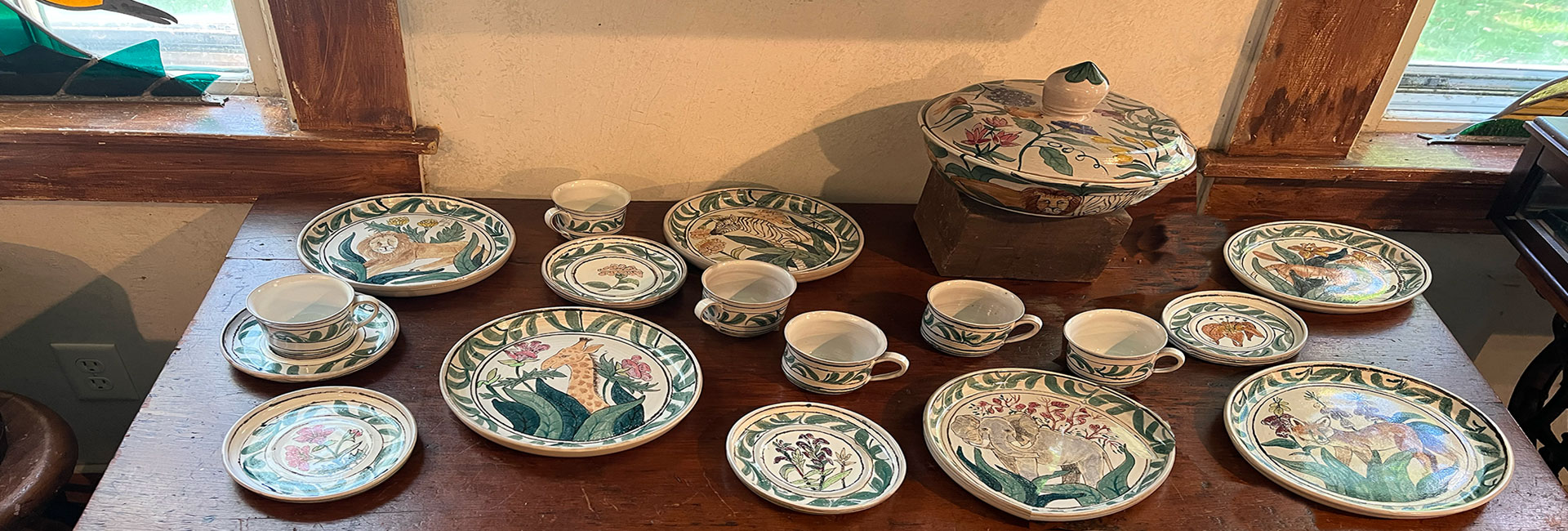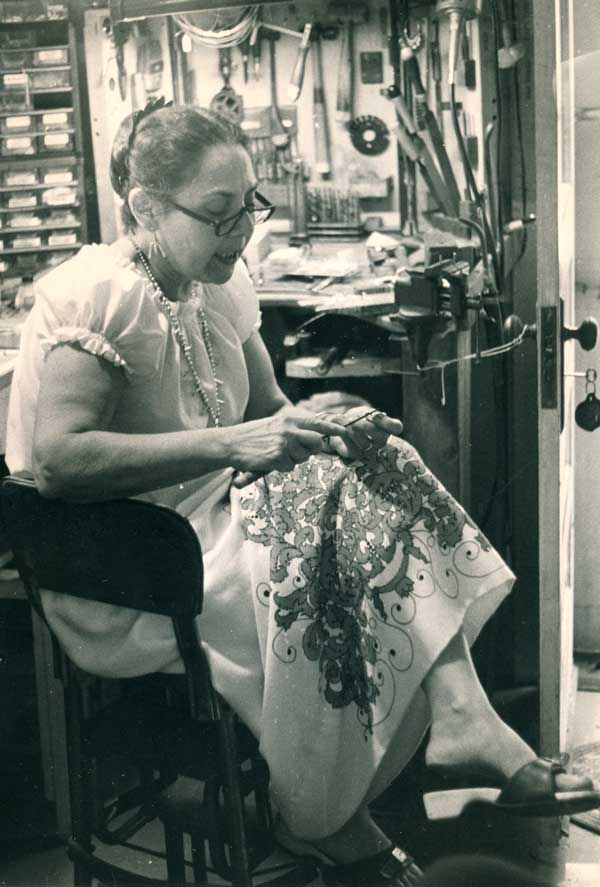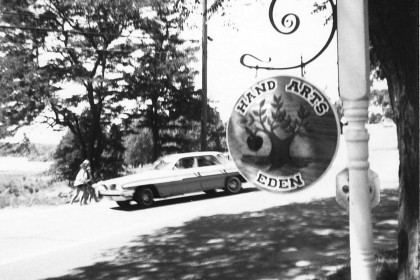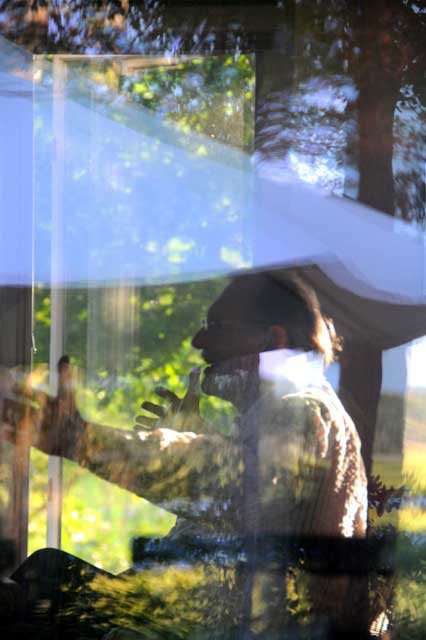
In the garden and now on the web (closed for the seaon).
In the beginning there was Eden…
A small part of the garden still remains on Route 6A in Dennis, Massachusetts. As in any garden, here one finds flowers, fruit and insects, and of course, in Eden, friendly beasts and birds fashioned in several media. As expected you will also find Eve. Noted for her unique Majolica, she fashions high temperature pottery painted with many colored glaze. Also at Eden is the well-known Eden® Cape Cod Screwball® bracelet, distinguished by its fit and simple elegant style. Designed by John Carey, it is still made on the premises.
Eve and J. C.’s daughter, Rachel Carey-Harper, is also a potter, jewelry designer and current owner of the family business. Come back to Eden where the serpent over the door is only a painted image, and admiration for our imagination is never forbidden.
Authenticity

Eden® tag
No other jewelry maker is authorized to manufacture or sell the Cape Cod Screwball® bracelet! Beyond the ethical considerations they are sometimes of questionable quality, fit and over-priced. To prove authenticity items are stamped Eden®. Our shop is the only place which designs, makes and sells authentic Eden Jewelry.
Current Owner…
Rachel Carey – Harper
Biography
Rachel Carey-Harper graduated from Clark U., Worcester, MA, in 1973 with a bachelor’s degree in art and sociology and, in 1977, received a Master of Education degree from Antioch College majoring in administration. She furthered her studies in New York City under Broadway designer Lester Polakov (1999 recipient of the Distinguished Achievement Award in Scenery) at the “Studio and Forum of Stage Design.”
In the 1970’s through the South Middlesex Opportunity Counsel, Rachel created a VISTA program of after-school traveling craft projects and a non-profit theater company called “Stages of Expression.”
In 1978 Esquire Jauchem hired her to do puppetry for Sarah Caldwell’s Opera Company of Boston production of Hansel and Gretel after which Rachel went on to work for 20 years as an assistant to the Broadway set designers Herbert Senn and Helen Pond and as Charge Scenic Artist for various opera and theater companies. The last major production she worked with Senn/Pond on was in 1995 for the Boston Ballet’s Nutcracker.
In 1984, she moved to Cape Cod and used her scenic artist skills in various ways. This included painting multiple murals, including the ones at the Wellfleet Cinemas and the Dennisport Post Office, and in 1990, creating the Clothesline Project, a worldwide large-scale artistic installation to bear witness to violence against women.
In 1998, she started to make her own ceramic designs, having helped her mother in the pottery studio since 1958. In 2002, as demand for her father’s Cape Cod Screwball bracelet design increased, she took over the business end of Eden Hand Arts, and in 2003, as demand exceeded production, Rachel Carey-Harper designed a system of tickets to manage logistics that kept the business alive. In 2006, after the deaths of both her mother and a few years earlier, her mentor set designer Herbert Senn, she designed the Teardrop bracelet. After the death of her father in 2013, she became Eden’s lead jewelry designer.
(For information about other aspects of Rachel’s creative work see Tools for Justice.)
Our origins…
Eve Carey (1920 – 2005)
Memorial Minute
Eve (Nathanson) Carey was born to Jeannette (Rosefield) Nathanson and (Joseph) George Nathanson in 1920 in Providence, Rhode Island. She graduated from the Rhode Island School of Design in 1943, studying at the Arts Students League in New York City under the Japanese painter Kuniyoshi. She continued her study in Provincetown, MA, where she worked as a jeweler and shared a storefront with the well-known artist Peter Hunt.
In 1946 Eve received a Masters of Arts degree in Ceramics from Alfred University, Alfred, New York. For her thesis she researched majolica, for it combined her passion for painting and her fondness for form. Eve had a particular gift of ingenious inspiration and perseverance. With these talents she was able to create glaze formulas that at high temperatures held their color and background. With these new glaze techniques, Eve replaced the original earthenware used by the early majolica potters. In 1948 she met and married John Arthur Carey II.
For the next few years Eve’s work was very well received. She sold pieces at Gumps, a store in San Francisco that at the time was quite elegant, as well as at various prestigious California galleries. In 1948 Eve Carey won first place award at the State fair in Mountain View California.
Her pots had a special smooth, satiny finish with lovely colors both subtle and bright. Her work, like her Italian mentors, had religious, mythical and allegorical themes. Some were whimsical representations of fables, myth and legends. Other pieces had more basic designs of blueberry branches, dogwoods or blue birds. Still other pieces rely on classic designs that are reminiscent of baroque or gothic patterns with acanthus leaves or gioch and with an almost oriental influence.
In the early 1950’s she moved back East when John accepted a teaching position at St. Marks School in Southboro MA. In 1962, when she and her husband John saw the property on Route 6A in Dennis, Massachusetts, they instinctively knew it was to be their home. The earth planted with apple trees, the birds singing, it was obvious that this was to be their Eden. In the description of their shop, Eden Hand Arts, Eve writes “In the beginning there was Eden. A small part of the Garden still remains on Rte. 6A in Dennis. As in any garden, here one finds flowers and fruit, insects, friendly beasts and birds.” Children and even grandchildren of her early customers are now customers.
Surrounded by roses, bluebells and ivy, Eve Carey’s studio was once a chicken coop. While most everyone else had to duck as they enter, her 4’11” frame perfectly fit the proportions of her space. Though she was small in stature, her influence on others was powerful Her humor, skill and sensitivity attracted every age.
Her artistic work continued to reflect her spiritual witness. A teapot was not simply a teapot. A teapot was a means of expressing the harmony in life. Often it will share a larger message and have a scene that could be a parable or a moral truth. For example, a common theme for Eve was the lion coexisting with the lamb. Even her designs that did not explicitly tell a story have a centered quality of peace. Often, customers shared the joy and happiness they feel when they drink out of one of her mugs. They said it brings them a sense of inner peace. They have shared how her work has brightened their spirit when they felt burdened or sad. In the last decade her work again gained recognition. She sold work to royalty and collectors from Cape Cod Massachusetts to Australia and is in the permanent collection at the Mills College Gallery for Ceramics in Berkeley CA.
Eve felt that for everyone, life could be Eden if you work at it. At St. Marks School she not only instructed her students in pottery but also counseled them “to listen to the voice within, make the outside world a better one and love life.”
For Eve, her work was an outward manifestation of her inner reality. Her life was grounded in the principles of equality, love, joy, peace and harmony. She was not content to simply speak the words of her Quaker faith; that all people have that of God within and that this spirit will speak to all who listen. Her life was a testament to these beliefs whether as a teacher, a friend, a mother or a potter.
Retirement would not be the noun to describe what Eve accomplished since leaving St.Marks School at the age of 67 in 1987. Along with her pottery, her time and attention went to her many friends, family, quilting, rug hooking and golf (which she bravely began at the age of 70). Also, every week during the summer she hosted a tea party for the people at the Cape Playhouse and especially her close friends and internationally renowned scenic designers, Helen Pond and Herbert Senn.
It seemed that Eve could work with focus and concentration even in the most violent tempest. There was no way anyone could approach her while she worked that didn’t startle her. Perhaps this is because she was so present, so focused in the moment. The theme of centeredness, so important in Quaker worship, was ever present in Eve’s life.
Her legacy lives on among her family and friends and she will be remembered as a warm and generous spirit. Living one moment at a time, she brought to life the beauty, the serenity and the joy that was and still is present at Eden.
John Arthur Carey II (1920 – 2012)
A Testimony about John Carey
“Nineteen years and one month ago, give or take some handful of days, I attended my last weekly afternoon tea at John and Eve Carey’s home in Dennis, MA, before I left to head back to California. Eve, a tiny little woman with long greying hair, was a potter; John, a gangly tall man who seemed to duck through doorways, was a silversmith/jewelry artisan. They hosted a weekly afternoon tea for the staff (actors, crew, and everyone else) of the Cape Playhouse, and I was lucky enough to be painting there for the summer. I had scrimped and saved so that I could buy a ring from John that day. All I wanted (good thing, because it was all I could afford) was a plain band for my little finger on my right hand. When things settled down and people were starting to leave, I asked him if he had time to sell me a ring. He took me back to his shop, and I told him what I wanted. But I have tiny fingers, and there were no bands small enough for me. I was disappointed, but didn’t want to be any trouble. John, though, insisted on making me one right then. He cut down a band I liked, and reformed it, and then started hammering down the seam while I watched. He was chatting away about buffing out the flat spot, and I told him, “No no, it’s fine like that, actually. I can see where you made it. I sort of like that.” He grinned at me and said, “Hang on, I have an idea.” The next thing I knew, he’d hammered bevels and facets and angles into the entire outer surface of the ring, all carefully and evenly spaced. When he was done, he took it off the pipe and handed it to me. “Go ahead and try it on—should fit perfectly, I think.” It did. It couldn’t have been more perfect. “Do you like it?” “Yeah, I do, John. It’s beautiful!” “Well, those ridges and bumps? Those won’t last. As you go through life, they’ll wear and round and smooth,” he winked at me, “Just like you will. But it’s soft, so it’ll never be perfectly shiny—the little scratches will always show.”
When I asked him if the price was still the same, he said, “Yes, still the same. It’s a gift.” He refused to take anything for it. After years of supporting the playhouse, John knew how little we all made, I’m sure, but I certainly didn’t expect that.
Since that day, that ring has only left my hand when I was so pregnant I had to take it off because my hands were so swollen, and, under doctor’s orders during a couple of surgeries, and then not without an argument from me (and I have won that argument at least once). For comparison, I take my wedding ring off every night, when I wash dishes, when I run, when I swim… this one stays on.
When my hands went back to normal after the kids were born, and I put the ring back on, I thought about writing to John to tell him how much all of that meant to me, and how it stuck with me. I even tracked down the address, and found out that Eve had died in 2005. but then life got in the way, and I got lazy, and I didn’t write. A couple days ago, I checked in with other people from the playhouse because I was ready to sit down and send a letter to John, and I had lost the address. It turns out that John died in 2012. Had I sent that letter when I meant to, he would have known the story. We weren’t close and hadn’t kept in touch, and of course he had much more important stories in his life; but still, to know that I missed that chance to give him that gift… that’s hard. I’ll send this story to his daughter, who now runs Eden, their estate, which has wonderful gardens you can tour (that started after I was there, though the gardens certainly existed at the time) and where her husband carries on John’s work. But the chance to tell John is long gone. He was quite a guy. Not a day goes by that I don’t fiddle with that ring—now almost perfectly rounded—and wonder where the edges went, and what caused the current set of scratches. RIP, John, and thank you.” —Brianna Bradley
“Life should be a search for Truth and Beauty, all else is mere existence.” —John Carey, 1984







